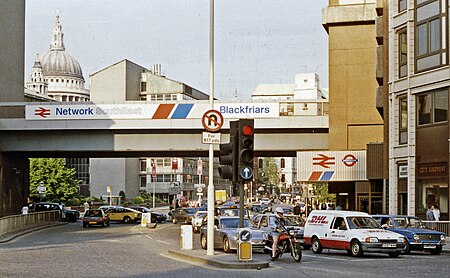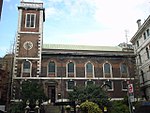Queen Victoria Street, London

Queen Victoria Street, named after the British monarch who reigned from 1837 to 1901, is a street in London which runs east by north from its junction with New Bridge Street and Victoria Embankment in the Castle Baynard ward of the City of London, along a section that divides the wards of Queenhithe and Bread Street, then lastly through the middle of Cordwainer ward, until it reaches Mansion House Street at Bank junction. Beyond Bank junction, the street continues north-east as Threadneedle Street which joins Bishopsgate. Other streets linked to Queen Victoria Street include Puddle Dock, Cannon Street, Walbrook and Poultry. The road was commissioned in 1861 to streamline the approach to the central business district, and was provided for through the Metropolitan Improvement Act. Costing over £1,000,000, it remains a major street within the City.The nearest London Underground stations are Blackfriars (at its western junction with New Bridge Street), Mansion House (where it crosses Cannon Street), and Bank (near its eastern end). Queen Victoria Street formed part of the marathon course of the 2012 Olympic and Paralympic Games.
Excerpt from the Wikipedia article Queen Victoria Street, London (License: CC BY-SA 3.0, Authors, Images).Queen Victoria Street, London
Queen Victoria Street, City of London
Geographical coordinates (GPS) Address Nearby Places Show on map
Geographical coordinates (GPS)
| Latitude | Longitude |
|---|---|
| N 51.512 ° | E -0.09993 ° |
Address
BT
Queen Victoria Street 135
EC4V 4AA City of London
England, United Kingdom
Open on Google Maps











